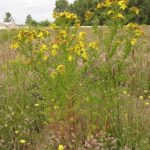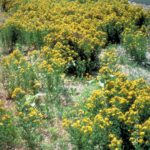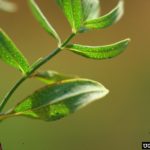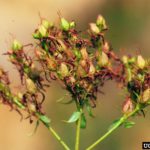Gallery:
- St. John’s wort flowers
- St. John’s wort flowers
- St. John’s wort
- St. John’s wort infestation
- St. John’s wort leaves, with tiny clear dots
- St. John’s wort in seed
Common names:
St. John’s wort, common St. John’s wort, Klamathweed
Scientific Name:
Hypericum perforatum
Description:
St. John’s wort is an upright perennial herbaceous plant in the Clusiaceae (St. John’s wort/ garcinia/mangosteen) family. It is found all over the world and is often considered weedy even in its native habitat. The flowers are bright yellow with five petals with occasional small black dots. The leaves are opposite, oblong, about 1 inch long, with tiny clear dots that can be seen when held up to light. It reproduces by rhizomes, creeping stems and seeds. One plant can produce 100,000 seeds in a year.
Life cycle:
Height of mature plants
1-2 feet
Flower color:
yellow
Bloom time:
Typically blooming during months when not in a purely vegetative state.
Look-a-likes:
From a distance, St. John’s wort is often confused with tansy ragwort. However, tansy ragwort leaves are much larger and lobed, and the flowers have about 13 petals, whereas common St. John’s wort flowers only have five.
Habitat:
St. John’s wort grows best in full sunlight on well drained soils. It can be found growing in pastures, range lands, logged areas, meadows, roadways, and railways.
Impacts:
St. John’s wort invades pasture and range lands and is poisonous to livestock if ingested, and can also cause skin problems. It is difficult to eradicate as seeds can stay viable in the soil for 10 to 30 years.
Noxious Weed Listing:
- WeedWise: maintenance
- State of Oregon: Class B
- State of Washington: Class C
- Four County CWMA: Class C
- Columbia Gorge CWMA: Class C
Origin:
North Africa, Asia, and Europe
Links:
Oregon Noxious Weed Profile
Washington Noxious Weed Profile
Invasive.org profile
CABI Invasive Species Compendium
Global Invasive Species Database






